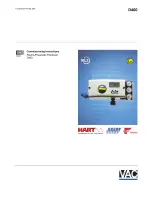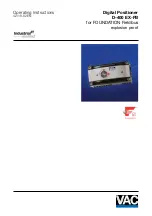
Logix
®
520MD+ and 510+ Digital Positioners FCD LGENIM0105-15-AQ – 05/16
74
RYRY
.
.
.
.
PRESSURE SENSOR BOARD FAILURE WARNING
Description: One or more pressure sensors may have failed.
Possible Solutions: Check the supply pressure to ensure it is between
1.3 and 10.3 bar (19 and 150 PSI). Check the pressure sensor board
connections. Recalibrate the pressure sensors. If the problem per-
sists, replace the pressure sensor board.
RYRR
.
.
..
MAIN BOARD ELECTRONIC FAILURE WARNING
Description: There has been an oscillator fault, position sensor ADC
failure, supply voltage error, reference voltage error, shunt voltage
error, or piezo voltage error.
Possible Solutions: This may be caused by transient conditions. If the
error persists, replace the main board.
RRGG
..
..
PILOT RELAY RESPONSE ALARM
Description: The pilot relay is sticking or extremely slow to respond.
This affects the responsiveness, increases the chance of limit cycling
and excessive air consumption. The pilot relay consists of the driver
module assembly with piezo (I-P relay) which is coupled to the
spool valve or poppet. Delayed response can be caused by a partially
clogged piezo or debris, oil, corrosion, or ice on the spool, or low
supply pressure.
Possible Solutions: Check response of the valve. If OK, adjust Pilot
Relay Response limits. Check the supply pressure. Check the spool
or poppet for debris, oil, corrosion, ice on the spool. Clean or replace
the spool assembly. Replace the piezo or driver module assembly.
Maintain a clean, water-free air/gas supply.
RRGY
..
.
.
FRICTION LOW ALARM
Description: The friction has passed below the user set limit. Low
friction is an indication of improperly loaded packing and, in severe
cases, can be an indication of the process fluid leaking at the valve
stem.
Possible Solutions: Check for a packing leak. Tighten or replace the
valve packing.
RRGR
..
.
.
FRICTION HIGH ALARM
Description: The valve and actuator friction has passed the user set
limit. High friction can cause loop oscillations, poor position control,
jerky motion, or valve sticking. It can be caused by build-up from the
process on the stem, trim or seat, by a failing bearing or guides in the
valve and actuator, galling of the trim or stem, excessively tightened
packing, linkages, or other valve or actuator mechanical issues.
Possible Solutions: Determine if the friction is significantly interfering
with the valve control. If not, consider increasing the friction warning
limit. Consider the following to reduce friction: Stroke the valve to
clear off build-up. Clear any external mechanical obstruction, loosen
the packing, clean the stem, repair or replace the actuator. Highly lo-
calized friction or very jerky travel can indicate internal galling. Repair
or replace internal valve components.
RRYG
..
.
.
FEEDBACK LINKAGE ALARM
Description: The feedback linkage is broken or the position feedback
POT is out of range.
Possible Solutions: Fix broken linkage or adjust feedback arm until full
motion is within the range of the POT.
RRYY
..
..
BACKLASH ALARM
Description: The amount of detected backlash has passed the user set
alarm limit. This may affect valve stability.
Possible Solutions: Check the stem and actuator for loose components.
RRYR
..
.
.
DRIVER MODULE ALARM
Description: The pilot relay can't open, the pilot relay can't shut, or the
Hall sensor circuit has failed.
Possible Solutions: Check the internal wiring connections. Replace the
pilot relay.































